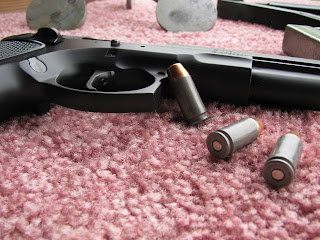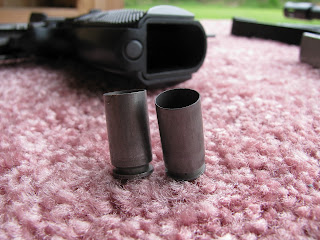 |
| 40 S&W reloaded Steel |
But what about new reloaders? When I first started reloading, a thousand 9mm could be purchased (once fired) for about 10 bucks plus shipping. As such, most people usually ordered a few thousand at a time from any of a number of individuals or retailers. 40 S&W was priced similarly, and even 45acp could be found for under 40 bucks per K (again once fired) with a bit of hunting. All of those prices have gone up- 9mm seems to be floating around the 25 dollar per K mark, with 40S&W going similarly. 45acp seems to trade well at over 50 bucks per K now (again, all once fired brass).
 |
| Max Charge of Unique |
The investment to reload has shot up exponentially if you price components- and steel could be the ticket to keeping price down for new reloaders- even if the steel is only a bridge until they can slowly build up brass stores.
I decided my last post wasn't enough- so I wanted to do more testing. This time, I picked the most controversial pistol caliber around- 40S&W. The Kaboom history of this round amongst reloaders is fairly high, and cases blowing out is common enough that you might know someone that actually experienced it.
I picked my range over for as many reloadable steel 40 S&W casings as I could find, and came up with 35. By the end of the experiment, I have none, but could have recovered about 9. More on that later.
 |
| after their final firing |
Test gun was my CZ75b SA. I fired the loads at my local club, recovered as many of the cases as possible, and repeated the experiment for 3 reloading cycles. By the last firing, I had 20 usable cases. 2 had been lost to cracked case mouths, the other 13 had just been lost. No noticeable differences in primer pockets, reloading force, or feeding in the gun was noted throughout the entire process. No cases blew out on me during firing, but I do admit that three max loadings was all I had the nerve to run through the gun before I lost my nerve.
 |
| primers after final firing |
Now I'm not an expert, nor should my practices be taken as advice on how you should treat your guns- I am saying though that for me, with the above formula in my gun- all was well for the cases I tried. If I had stayed more within my standard 40SW loadings (155gr LTC bullet at 6.2 gr unique) I would have kept these cases around a while longer. That load (according to the lee second edition) runs at a minimum of 1000 less PSI.
I learned that you can push steel a bit (at least in handgun rounds) and it holds up just fine. I didn't have the nerve to see how long it would hold up, but frankly I don't think it is necessary. if a person can buy boxer cased steel ammo cheap, and get 2-3 loads out of it even in a high pressure pistol round- that isn't doing too bad. A total of 4 firings from a piece of brass, though not good, is not unheard of, especially if a person is running them hot. With moderate loads, 5 or 6 loadings (or more in 45acp- or at least that has been my experience) starts getting into the solidly acceptable range of brass life (38 spl and 45acp excluded- I have cases that I got from reloaders that must have dozens of firings on them in those calibers- and I still use em).
 |
| side view of cases after final firing |
for those interested, I was using lee carbide 40SW dies in a lee pro 1000 press. I chose Unique because I load almost all my handguns with it, and the only other powder I had on hand (but not enough to play with) was Reddot- which puts out almost the same pressure in max loads (according to my lee book anyway). I bought the press used in 2004, so I have no idea how old it really is- and the dies are from 2005-2006ish. They have between 4-6k reloads on them. The majority of what they have reloaded has been nickle and brass, with 155gr LTC or 165 gr plated JHP. So I would put there wear as negligible.
 |
| view inside case after last firing |
Hiç yorum yok:
Yorum Gönder